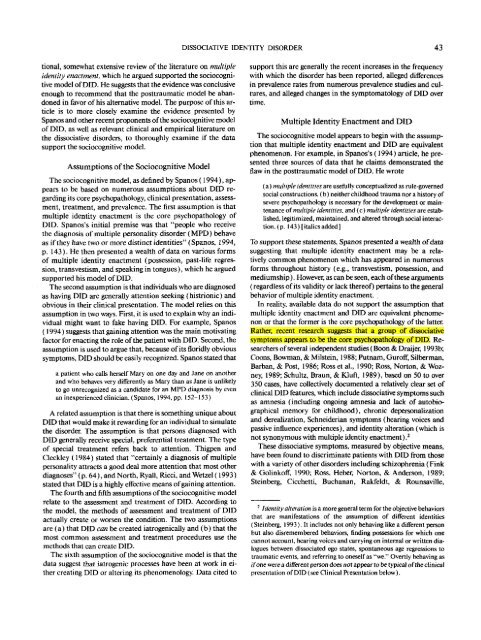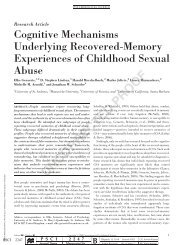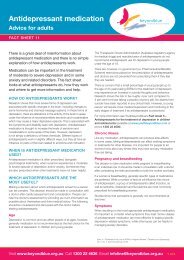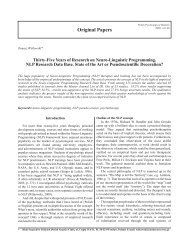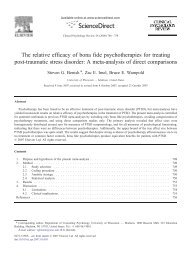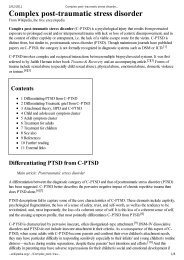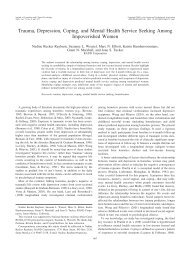The Sociocognitive Model of Dissociative Identity Disorder: A ...
The Sociocognitive Model of Dissociative Identity Disorder: A ...
The Sociocognitive Model of Dissociative Identity Disorder: A ...
You also want an ePaper? Increase the reach of your titles
YUMPU automatically turns print PDFs into web optimized ePapers that Google loves.
DISSOCIATIVE IDENTITY DISORDER 43<br />
tional, somewhat extensive review <strong>of</strong> the literature on multiple<br />
identity enactment, which he argued supported the sociocognitive<br />
model <strong>of</strong> DID. He suggests that the evidence was conclusive<br />
enough to recommend that the posttraumatic model be abandoned<br />
in favor <strong>of</strong> his alternative model. <strong>The</strong> purpose <strong>of</strong> this article<br />
is to more closely examine the evidence presented by<br />
Spanos and other recent proponents <strong>of</strong> the sociocognitive model<br />
<strong>of</strong> DID, as well as relevant clinical and empirical literature on<br />
the dissociative disorders, to thoroughly examine if the data<br />
support the sociocognitive model.<br />
Assumptions <strong>of</strong> the <strong>Sociocognitive</strong> <strong>Model</strong><br />
<strong>The</strong> sociocognitive model, as denned by Spanos (1994), appears<br />
to be based on numerous assumptions about DID regarding<br />
its core psychopathology, clinical presentation, assessment,<br />
treatment, and prevalence. <strong>The</strong> first assumption is that<br />
multiple identity enactment is the core psychopathology <strong>of</strong><br />
DID. Spanos's initial premise was that "people who receive<br />
the diagnosis <strong>of</strong> multiple personality disorder (MPD) behave<br />
as if they have two or more distinct identities" (Spanos, 1994,<br />
p. 143). He then presented a wealth <strong>of</strong> data on various forms<br />
<strong>of</strong> multiple identity enactment (possession, past-life regression,<br />
transvestism, and speaking in tongues), which he argued<br />
supported his model <strong>of</strong> DID.<br />
<strong>The</strong> second assumption is that individuals who are diagnosed<br />
as having DID are generally attention seeking (histrionic) and<br />
obvious in their clinical presentation. <strong>The</strong> model relies on this<br />
assumption in two ways. First, it is used to explain why an individual<br />
might want W fake having DID. For example, Spanos<br />
(1994) suggests that gaining attention was the main motivating<br />
factor for enacting the role <strong>of</strong> the patient with DID. Second, the<br />
assumption is used to argue that, because <strong>of</strong> its floridly obvious<br />
symptoms, DID should be easily recognized. Spanos stated that<br />
a patient who calls herself Mary on one day and Jane on another<br />
and who behaves very differently as Mary than as Jane is unlikely<br />
to go unrecognized as a candidate for an MPD diagnosis by even<br />
an inexperienced clinician. (Spanos, 1994, pp. 152-153)<br />
A related assumption is that there is something unique about<br />
DID that would make it rewarding for an individual to simulate<br />
the disorder. <strong>The</strong> assumption is that persons diagnosed with<br />
DID generally receive special, preferential treatment. <strong>The</strong> type<br />
<strong>of</strong> special treatment refers back to attention. Thigpen and<br />
Cleckley (1984) stated that "certainly a diagnosis <strong>of</strong> multiple<br />
personality attracts a good deal more attention that most other<br />
diagnoses" (p. 64), and North, Ryall, Ricci, and Wetzel (1993)<br />
stated that DID is a highly effective means <strong>of</strong> gaining attention.<br />
<strong>The</strong> fourth and fifth assumptions <strong>of</strong> the sociocognitive model<br />
relate to the assessment and treatment <strong>of</strong> DID. According to<br />
the model, the methods <strong>of</strong> assessment and treatment <strong>of</strong> DID<br />
actually create or worsen the condition. <strong>The</strong> two assumptions<br />
are (a) that DID can be created iatrogenically and (b) that the<br />
most common assessment and treatment procedures use the<br />
methods that can create DID.<br />
<strong>The</strong> sixth assumption <strong>of</strong> the sociocognitive model is that the<br />
data suggest that iatrogenic processes have been at work in either<br />
creating DID or altering its phenomenology. Data cited to<br />
support this are generally the recent increases in the frequency<br />
with which the disorder has been reported, alleged differences<br />
in prevalence rates from numerous prevalence studies and cultures,<br />
and alleged changes in the symptomatology <strong>of</strong> DID over<br />
time.<br />
Multiple <strong>Identity</strong> Enactment and DID<br />
<strong>The</strong> sociocognitive model appears to begin with the assumption<br />
that multiple identity enactment and DID are equivalent<br />
phenomenon. For example, in Spanos's (1994) article, he presented<br />
three sources <strong>of</strong> data that he claims demonstrated the<br />
flaw in the posttraumatic model <strong>of</strong> DID. He wrote<br />
(a) multiple identities are usefully conceptualized as rule-governed<br />
social constructions, (b) neither childhood trauma nor a history <strong>of</strong><br />
severe psychopathology is necessary for the development or maintenance<br />
<strong>of</strong> multiple identities, and (c) multiple identities are established,<br />
legitimized, maintained, and altered through social interaction,<br />
(p. 143) [italics added]<br />
To support these statements, Spanos presented a wealth <strong>of</strong> data<br />
suggesting that multiple identity enactment may be a relatively<br />
common phenomenon which has appeared in numerous<br />
forms throughout history (e.g., transvestism, possession, and<br />
mediumship). However, as can be seen, each <strong>of</strong> these arguments<br />
(regardless <strong>of</strong> its validity or lack there<strong>of</strong>) pertains to the general<br />
behavior <strong>of</strong> multiple identity enactment. .<br />
In reality, available data do not support the assumption that<br />
multiple identity enactment and DID are equivalent phenomenon<br />
or that the former is the core psychopathology <strong>of</strong> the latter.<br />
Rather, recent research suggests that a group <strong>of</strong> dissociative<br />
symptoms appears to be the core psychopathology <strong>of</strong> DID. Researchers<br />
<strong>of</strong> several independent studies (Boon & Draijer, 1993b;<br />
Coons, Bowman, & Milstein, 1988; Putnam, Gur<strong>of</strong>f, Silberman,<br />
Barban, & Post, 1986; Ross et al., 1990; Ross, Norton, & Wozney,<br />
1989; Schultz, Braun, & Kluft, 1989), based on 50 to over<br />
350 cases, have collectively documented a relatively clear set <strong>of</strong><br />
clinical DID features, which include dissociative symptoms such<br />
as amnesia (including ongoing amnesia and lack <strong>of</strong> autobiographical<br />
memory for childhood), chronic depersonalization<br />
and derealization, Schneiderian symptoms (hearing voices and<br />
passive influence experiences), and identity alteration (which is<br />
not synonymous with multiple identity enactment). 2<br />
<strong>The</strong>se dissociative symptoms, measured by objective means,<br />
have been found to discriminate patients with DID from those<br />
with a variety <strong>of</strong> other disorders including schizophrenia (Fink<br />
& Golink<strong>of</strong>f, 1990; Ross, Heber, Norton, & Anderson, 1989;<br />
Steinberg, Cicchetti, Buchanan, Rakfeldt, & Rounsaville,<br />
3 <strong>Identity</strong> alteration is a more general term for the objective behaviors<br />
that are manifestations <strong>of</strong> the assumption <strong>of</strong> different identities<br />
(Steinberg, 1993). It includes not only behaving like a different person<br />
but also disremembered behaviors, finding possessions for which one<br />
cannot account, hearing voices and carrying on internal or written dialogues<br />
between dissociated ego states, spontaneous age regressions to<br />
traumatic events, and referring to oneself as "we." Overtly behaving as<br />
if one were a different person does not appearto be typical <strong>of</strong> the clinical<br />
presentation <strong>of</strong> DID (see Clinical Presentation below).


